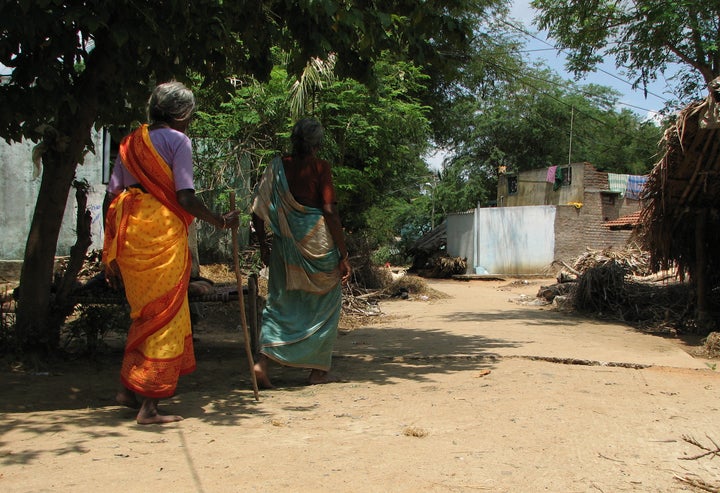
When 14-year-old Ragini asked her parents why she had to become a sex worker, they replied calmly, “Why? This is our work. This is what you have to do.” As a young woman from the Perna tribe of North India who was reaching puberty, she had no choice. She knew from a young age that she too would one day be doing the work that her mother, grandmother, older sisters, and cousins had done before her. She would not be alone—the other young girls that she grew up with, her best friends, would join her too, as soon as they were married.
Ragini is part of the Perna, a nomadic Indian tribe that practices sex work as tradition. Girls are married soon after menarche, and after the birth of their first child, are prostituted by their in-laws. Generally known as intergenerational sex work, or cultural sex work, there are a number of nomadic tribes throughout India in which women are prostituted in this way, often by their own families, for economic gain.
Unlike traditional brothel-based prostitution, in which girls are kidnapped and trafficked from rural areas or across borders from Nepal and Pakistan, those in the Perna community live otherwise normal lives. Most girls grow up in a household with siblings, grandparents, a mother, and father. Many come to understand that sex work is simply a part of what their tribe has always done. In speaking to elderly Perna women and men, they consistently described that this was the work of their ancestors, although a few claimed they had to take up the trade due to poverty.
Types of Cultural Sex Work in India
The Perna community is one of many in India that continue in what is today understood as “cultural” sex work. Across tribes there are significant similarities yet defining features as well. For most, sex work was taken up primarily as a result of the British Criminal Tribes Act in 1871 forbidding performing communities—jesters, snake charmers, dancers, acrobats, and similar types of workers—from their traditional livelihoods. Today, it is unclear exactly how many tribes are involved in sex work across the country.
The Nat community, which resides in several states in North and East India, has similar origins to the Pernas. Traditionally a performing tribe that entertained in the courts of Rajput rulers of Rajasthan, the community transitioned into economic hardship followed by sex work. The fate of girls is decided within two to three years of life—they will either become sex workers, or not. This depends heavily on the economic situation of the family, which is dependent on if other women in the family are working.
Of similar roots, the Kanjars were at one point entertainers and dancers, although their history in criminal activity is also well-documented. The community primarily resides in North India and Pakistan, and girls are forced into sex work by their families if they are considered physically attractive and likely to earn significantly.
In the Bedia community, found largely in the state of Uttar Pradesh, girls are given the option to either get married or work in the sex trade. Wives are forbidden from prostituting, while sisters who choose to go unmarried must commit to being sex workers for their lives. Wives in the Bedia community become responsible for the household, including cooking, cleaning, and raising children, while sisters become the main economic earners. The Bedia community is distinct from Pernas in that wives are strictly forbidden from sex work in the former, and are forced in the latter.
The Devadasi (the word literally translates to “servant of God”) community is located primarily in South India, and has a slightly different approach. Girls are dedicated at a young age to the goddess Yellama through a ritual procedure carried out by a religious leader in the community. This usually occurs in early childhood, although sex work does not begin until menarche. The group is considered part of the “untouchable” caste. They vary from the other groups in that their role in the community becomes one of religious devotion, although sex work is still enforced as tradition.
Shared Culture, Shared Struggles
Some general similarities exist across the groups. For instance, the birth of a female is celebrated in these communities as it is a sign of future earnings. Households enjoy significantly higher income than those of other tribal groups, creating deep-rooted economic systems that are challenging to undermine. Most men do not work, and have high rates of substance abuse. Relatedly, domestic violence is commonplace. Some of the women, especially from the Kanjar and Nat communities, are also trafficked to brothel-based prostitution, while those in the Perna and Bedia communities practice home-based or street-based prostitution. Many of these tribes have also been known to kidnap girls from neighboring communities and raise them before trafficking the girls to big cities.
Culturally, they share linguistic dialects and folklore traditions that are largely unknown to outsiders. Their similarities are close enough that they can often identify members of other sex worker tribes.
The communities are highly stigmatized by Indian society, and have very low levels of education and access to healthcare services. Children are bullied in schools, and often drop-out during primary education. Despite efforts of several NGOs, these communities remain marginalized and largely unrecognized.
Cultural sex work in India is especially challenging because of the community solidarity and belief in tradition. Many women, especially those who had been working for multiple years, stood in defense of their traditional work. As put by Nandini, a Perna woman, “Why does society continue looking at us? There are other women out there who are prostituting as well.”
Promoting Health to Destabilize Oppression
As a physician and public health researcher, I believe that access to healthcare is a means of empowering the women in these communities. Many Perna women with whom I spoke cited health concerns as the most debilitating aspect of their lives. Mental health issues were particularly evident. Many women suffered from depressive symptoms, such as trouble sleeping, feelings of sadness, and suicidal thoughts. Others spoke of psychosis in which women would imagine voices speaking to them, and some instances of feeling possessed by “demons”. Violence from clients, as well as domestic violence with their husbands and in-laws were commonly brought up. Similarly, substance abuse among both women and men, primarily alcohol and unfiltered local Indian cigarettes (bidis), was of significant concern. Sexually transmitted infection risk is inherent in these communities, and difficulties negotiating condom use, stigma against HIV and other STI testing, and lack of access to family planning services all create undue burden on women in cultural sex work.
To complicate matters further, women in cultural sex work communities have very limited access to healthcare services, primarily because of stigma plaguing their local healthcare systems. Women in the Perna community, for instance, feared sharing private health information (such as HIV status) with doctors in the area because of past instances in which doctors had shared this with other patients, which worsened sentiments of hatred and discrimination against Perna women from the public.
With poor health, the struggle of finding economic alternatives to sex work becomes all the more challenging. A woman living in a household with domestic violence and substance abuse faces a far more complex situation with regards to protecting herself and her children. And women without stable primary care access have no reliable means of monitoring their health and well-being, and are more prone to health catastrophes. I believe that a fundamental first-step to overcoming systematic oppression against women in cultural sex work is to ensure that they are embraced by the healthcare system through both public health outreach and facilitation of access to comprehensive services.
